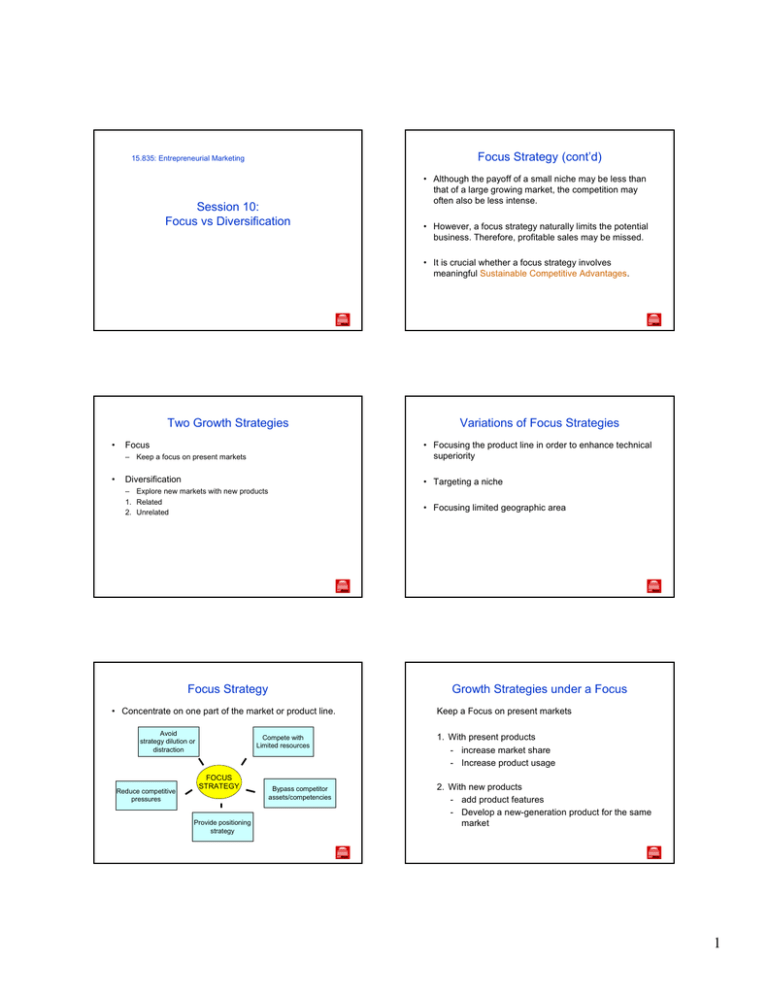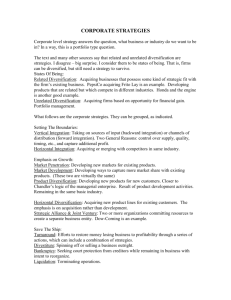Focus Strategy (cont’d)
advertisement

Focus Strategy (cont’d) 15.835: Entrepreneurial Marketing Session 10: Focus vs Diversification • Although the payoff of a small niche may be less than that of a large growing market, the competition may often also be less intense. • However, a focus strategy naturally limits the potential business. Therefore, profitable sales may be missed. • It is crucial whether a focus strategy involves meaningful Sustainable Competitive Advantages. Two Growth Strategies • • Focus Variations of Focus Strategies – Keep a focus on present markets • Focusing the product line in order to enhance technical superiority Diversification • Targeting a niche – Explore new markets with new products 1. Related 2. Unrelated • Focusing limited geographic area Focus Strategy Growth Strategies under a Focus • Concentrate on one part of the market or product line. Avoid strategy dilution or distraction Reduce competitive pressures Compete with Limited resources FOCUS STRATEGY Provide positioning strategy Bypass competitor assets/competencies Keep a Focus on present markets 1. With present products - increase market share - Increase product usage 2. With new products - add product features - Develop a new-generation product for the same market 1 Diversification • Approach new markets with new products • Two types – Related diversification • The new business area has meaningful commonalities with the core business. – Unrelated diversification • Unrelated diversification lacks enough commonalities. • The objectives are therefore mainly financial, to generate profit streams that are either larger, less uncertain, or more stable that they would be otherwise. Performance of Diversified Firms (cont’d) • From 1950 to 1980, among 2021 acquisitions made in new industries by 33 large, diversified U.S. companies, More than half were divested by 1986 (Porter, HBR, 1987) • Among 931 unrelated diversifications, 74% were divested (Porter, HBR, 1987). • In a sample of Fortune 500 firms, the related diversifications were highest in performance, followed by the less related diversification and finally the unrelated diversification (Rumelt, Strategic Management Journal, 1982) • 450 related diversifications had a significantly higher ROA than 20 unrelated diversification firms (Simmonds, Strategic Management Journal 1990) Motivations for Diversification Related Diversification yExchange or share assets or competencies by exploiting - Strong brand name - Strong marketing skills - Strong distribution capacity - Manufacturing skills - R&D capability Unrelated Diversification y Manage and allocate cash flow y Enter business areas with high ROI prospects y Refocus a firm Risk of Unrelated Diversification • Unrelated diversification, if unsuccessful, may actually damage the original core business by diverting attention and resources from it. • Managing the new business may be difficult because it requires different assets and resources. yReduce risk by operating in multiple product markets y Vertical integration Performance of Diversified Firms • In the 1960s and early 1970s, a wave of acquisitions took place. – Typically, friendly mergers involving unrelated diversification. – The fraction of single-business companies in the Fortune 500 dropped from 23% to 15% from 1959 to 1969. – The percentage of conglomerates with no dominant business rose from 7.3% to 19%. Issues in Diversification • The important issue in diversification is how to achieve synergy. In unrelated diversifications, there is no possibility of synergy. • Successful diversification requires a common core or unity represented by common markets, technology, or production processes. Without such unity, diversification is unlikely to work. • Were they successful? 2



